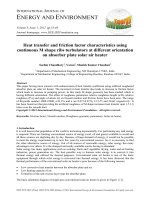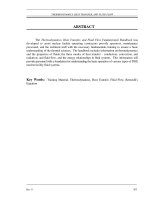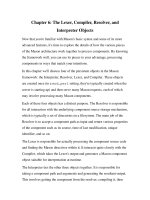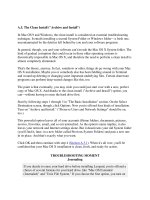The Thermodynamics, Heat Transfer, and Fluid Flow Fundamentals Handbook
Bạn đang xem bản rút gọn của tài liệu. Xem và tải ngay bản đầy đủ của tài liệu tại đây (3.58 MB, 274 trang )
THERMODYNAMICS, HEAT TRANSFER, AND FLUID FLOW
Rev. 0 HT
ABSTRACT
The Thermodynamics, Heat Transfer, and Fluid Flow Fundamentals Handbook was
developed to assist nuclear facility operating contractors provide operators, maintenance
personnel, and the technical staff with the necessary fundamentals training to ensure a basic
understanding of the thermal sciences. The handbook includes information on thermodynamics
and the properties of fluids; the three modes of heat transfer - conduction, convection, and
radiation; and fluid flow, and the energy relationships in fluid systems. This information will
provide personnel with a foundation for understanding the basic operation of various types of DOE
nuclear facility fluid systems.
Key Words:
Training Material, Thermodynamics, Heat Transfer, Fluid Flow, Bernoulli's
Equation
THERMODYNAMICS, HEAT TRANSFER, AND FLUID FLOW
Rev. 0 HT
OVERVIEW
The Department of Energy Fundamentals Handbook entitled Thermodynamics, Heat
Transfer, and Fluid Flow was prepared as an information resource for personnel who are
responsible for the operation of the Department's nuclear facilities. A basic understanding of the
thermal sciences is necessary for DOE nuclear facility operators, maintenance personnel, and the
technical staff to safely operate and maintain the facility and facility support systems. The
information in the handbook is presented to provide a foundation for applying engineering
concepts to the job. This knowledge will help personnel more fully understand the impact that
their actions may have on the safe and reliable operation of facility components and systems.
The Thermodynamics, Heat Transfer, and Fluid Flow handbook consists of three modules
that are contained in three volumes. The following is a brief description of the information
presented in each module of the handbook.
Volume 1 of 3
Module 1 - Thermodynamics
This module explains the properties of fluids and how those properties are
affected by various processes. The module also explains how energy balances can
be performed on facility systems or components and how efficiency can be
calculated.
Volume 2 of 3
Module 2 - Heat Transfer
This module describes conduction, convection, and radiation heat transfer. The
module also explains how specific parameters can affect the rate of heat transfer.
Volume 3 of 3
Module 3 - Fluid Flow
This module describes the relationship between the different types of energy in a
fluid stream through the use of Bernoulli's equation. The module also discusses
the causes of head loss in fluid systems and what factors affect head loss.
THERMODYNAMICS, HEAT TRANSFER, AND FLUID FLOW
Rev. 0 HT
The information contained in this handbook is by no means all encompassing. An
attempt to present the entire subject of thermodynamics, heat transfer, and fluid flow would be
impractical. However, the Thermodynamics, Heat Transfer, and Fluid Flow handbook does
present enough information to provide the reader with a fundamental knowledge level sufficient
to understand the advanced theoretical concepts presented in other subject areas, and to better
understand basic system and equipment operations.
Department of Energy
Fundamentals Handbook
THERMODYNAMICS, HEAT TRANSFER,
AND FLUID FLOW
Module 1
Thermodynamics
Thermodynamics TABLE OF CONTENTS
TABLE OF CONTENTS
LIST OF FIGURES ................................................. iv
LIST OF TABLES .................................................. vii
REFERENCES .................................................... viii
OBJECTIVES ...................................................... x
THERMODYNAMIC PROPERTIES ...................................... 1
Mass and Weight ............................................... 1
Specific Volume ............................................... 3
Density ..................................................... 3
Specific Gravity ............................................... 4
Humidity .................................................... 4
Intensive and Extensive Properties ................................... 4
Summary .................................................... 5
TEMPERATURE AND PRESSURE MEASUREMENTS ........................ 6
Temperature .................................................. 6
Temperature Scales ............................................. 6
Pressure ..................................................... 9
Pressure Scales ................................................ 9
Summary ................................................... 12
ENERGY, WORK, AND HEAT ........................................ 14
Energy ..................................................... 14
Potential Energy .............................................. 14
Kinetic Energy ............................................... 15
Specific Internal Energy ......................................... 16
Specific P-V Energy ........................................... 17
Specific Enthalpy ............................................. 18
Work ...................................................... 18
Heat ....................................................... 19
Entropy .................................................... 22
Energy and Power Equivalences ................................... 23
Summary ................................................... 25
Rev. 0 Page i HT-01
TABLE OF CONTENTS Thermodynamics
TABLE OF CONTENTS (Cont.)
THERMODYNAMIC SYSTEMS AND PROCESSES ......................... 26
Thermodynamic Systems and Surroundings ........................... 26
Types of Thermodynamic Systems ................................. 27
Thermodynamic Equilibrium ...................................... 27
Control Volume .............................................. 27
Steady State ................................................. 27
Thermodynamic Process ......................................... 28
Cyclic Process ................................................ 28
Reversible Process ............................................. 28
Irreversible Process ............................................ 28
Adiabatic Process ............................................. 29
Isentropic Process ............................................. 29
Polytropic Process ............................................. 29
Throttling Process ............................................. 29
Summary ................................................... 30
CHANGE OF PHASE ............................................... 31
Classification of Properties ....................................... 31
Saturation ................................................... 33
Saturated and Subcooled Liquids ................................... 33
Quality ..................................................... 34
Moisture Content .............................................. 35
Saturated and Superheated Vapors .................................. 35
Constant Pressure Heat Addition ................................... 35
Critical Point ................................................ 36
Fusion ..................................................... 36
Sublimation ................................................. 37
Triple Point ................................................. 37
Condensation ................................................ 38
Summary ................................................... 39
PROPERTY DIAGRAMS AND STEAM TABLES ........................... 41
Property Diagrams ............................................. 41
Pressure-Temperature (P-T) Diagram ................................ 42
Pressure-Specific Volume (P-v) Diagram ............................. 43
Pressure-Enthalpy (P-h) Diagram ................................... 44
Enthalpy-Temperature (h-T) Diagram ................................ 45
HT-01 Page ii Rev. 0
Thermodynamics TABLE OF CONTENTS
TABLE OF CONTENTS (Cont.)
Temperature-Entropy (T-s) Diagram ................................ 46
Enthalpy-Entropy (h-s) or Mollier Diagram ........................... 47
Steam Tables ................................................ 47
Summary ................................................... 52
FIRST LAW OF THERMODYNAMICS .................................. 53
First Law of Thermodynamics ..................................... 53
Summary ................................................... 68
SECOND LAW OF THERMODYNAMICS ................................ 69
Second Law of Thermodynamics ................................... 69
Entropy .................................................... 70
Carnot’s Principle ............................................. 71
Carnot Cycle ................................................. 71
Diagrams of Ideal and Real Processes ............................... 77
Power Plant Components ........................................ 78
Heat Rejection ............................................... 85
Typical Steam Cycle ........................................... 90
Causes of Inefficiency .......................................... 95
Summary ................................................... 96
COMPRESSION PROCESSES ......................................... 97
Boyle’s and Charles’ Laws ....................................... 97
Ideal Gas Law ................................................ 98
Fluid ...................................................... 99
Compressibility of Fluids ........................................ 99
Constant Pressure Process ........................................100
Constant Volume Process ........................................100
Effects of Pressure Changes on Fluid Properties ........................100
Effects of Temperature Changes on Fluid Properties .....................101
Summary ...................................................102
APPENDIX A Thermodynamics ....................................... A-1
Rev. 0 Page iii HT-01
LIST OF FIGURES Thermodynamics
LIST OF FIGURES
Figure 1 Comparison of Temperature Scales ................................ 7
Figure 2 Pressure Relationships ......................................... 9
Figure 3 Intensive Properties .......................................... 32
Figure 4 Piston-Cylinder Arrangement ................................... 33
Figure 5 Vapor Pressure Curve ........................................ 33
Figure 6 T-V Diagram Showing the Saturation Region ....................... 34
Figure 7 T-V Diagram .............................................. 35
Figure 8 Pressure-Temperature Diagram .................................. 38
Figure 9 P-T Diagram for Water ....................................... 42
Figure 10 P-v Diagram for Water ....................................... 43
Figure 11 P-h Diagram for Water ....................................... 44
Figure 12 h-T Diagram for Water ....................................... 45
Figure 13 T-s Diagram for Water ....................................... 46
Figure 14 First Law of Thermodynamics .................................. 55
Figure 15 Control Volume Concepts ..................................... 56
Figure 16 Open System Control Volumes ................................. 57
Figure 17 Open System Control Volumes (Cont.) ............................ 58
Figure 18 Mulitple Control Volumes in Same System ......................... 58
Figure 19 T-s Diagram with Rankine Cycles ............................... 61
HT-01 Page iv Rev. 0
Thermodynamics LIST OF FIGURES
LIST OF FIGURES (Cont.)
Figure 20 Typical Steam Plant Cycle .................................... 62
Figure 21 Carnot Cycle Representation ................................... 73
Figure 22 Real Process Cycle Compared to Carnot Cycle ...................... 75
Figure 23 Control Volume for Second Law Analysis ......................... 76
Figure 24 Expansion and Compression Processes on T-s Diagram ................ 78
Figure 25 Expansion and Compression Processes on h-s Diagram ................ 78
Figure 26 Steam Cycle .............................................. 78
Figure 27 Comparison of Ideal and Actual Turbine Performances ................. 80
Figure 28 Carnot Cycle .............................................. 85
Figure 29 Carnot Cycle vs. Typical Power Cycle Available Energy ............... 86
Figure 30 Ideal Carnot Cycle .......................................... 87
Figure 31 Rankine Cycle ............................................. 88
Figure 32 Rankine Cycle with Real v.s. Ideal ............................... 89
Figure 33 Rankine Cycle Efficiencies T-s ................................. 89
Figure 34 h-s Diagram .............................................. 90
Figure 35 Typical Steam Cycle ........................................ 91
Figure 36 Steam Cycle (Ideal) ......................................... 92
Figure 37 Steam Cycle (Real) ......................................... 92
Figure 38 Mollier Diagram ........................................... 93
Figure 39 Ideal Gas Constant Values .................................... 98
Figure 40 Pressure-Volume Diagram ..................................... 99
Rev. 0 Page v HT-01
LIST OF FIGURES Thermodynamics
LIST OF FIGURES (Cont.)
Figure A-1 Mollier Diagram ......................................... A-1
Figure A-2 Sample Steam Tables ...................................... A-3
Figure A-3 Thermodynamic Properties of Mercury .......................... A-5
Figure A-4 Thermodynamic Properties of CO
2
............................ A-7
HT-01 Page vi Rev. 0
Thermodynamics LIST OF TABLES
LIST OF TABLES
NONE
Rev. 0 Page vii HT-01
REFERENCES Thermodynamics
REFERENCES
VanWylen, G. J. and Sonntag, R. E., Fundamentals of Classical Thermodynamics
SI Version, 2nd Edition, John Wiley and Sons, New York, ISBN 0-471-04188-2.
Kreith, Frank, Principles of Heat Transfer, 3rd Edition, Intext Press, Inc., New
York, ISBN 0-7002-2422-X.
Holman, J. P., Thermodynamics, McGraw-Hill, New York.
Streeter, Victor, L., Fluid Mechanics, 5th Edition, McGraw-Hill, New York, ISBN
07-062191-9.
Rynolds, W. C. and Perkins, H. C., Engineering Thermodynamics, 2nd Edition,
McGraw-Hill, New York, ISBN 0-07-052046-1.
Meriam, J. L., Engineering Mechanics Statics and Dynamics, John Wiley and
Sons, New York, ISBN 0-471-01979-8.
Schneider, P. J. Conduction Heat Transfer, Addison-Wesley Pub. Co., California.
Holman, J. P., Heat Transfer, 3rd Edition, McGraw-Hill, New York.
Knudsen, J. G. and Katz, D. L., Fluid Dynamics and Heat Transfer, McGraw-Hill,
New York.
Kays, W. and London, A. L., Compact Heat Exchangers, 2nd Edition, McGraw-
Hill, New York.
Weibelt, J. A., Engineering Radiation Heat Transfer, Holt, Rinehart and Winston
Publish., New York.
Sparrow, E. M. and Cess, R. E., Radiation Heat Transfer, Brooks/Cole Publish.
Co., Belmont, California.
Hamilton, D. C. and Morgan, N. R., Radiant-Interchange Configuration Factors,
Tech. Note 2836, National Advisory Committee for Aeronautics.
HT-01 Page viii Rev. 0
Thermodynamics REFERENCES
REFERENCES (Cont.)
McDonald, A. T. and Fox, R. W., Introduction to Fluid mechanics, 2nd Edition,
John Wiley and Sons, New York, ISBN 0-471-01909-7.
Zucrow, M. J. and Hoffman, J. D., Gas Dynamics Vol.b1, John Wiley and Sons,
New York, ISBN 0-471-98440-X.
Crane Company, Flow of Fluids Through Valves, Fittings, and Pipe, Crane Co.
Technical Paper No. 410, Chicago, Illinois, 1957.
Esposito, Anthony, Fluid Power with Applications, Prentice-Hall, Inc., New
Jersey, ISBN 0-13-322701-4.
Beckwith, T. G. and Buck, N. L., Mechanical Measurements, Addison-Wesley
Publish Co., California.
Wallis, Graham, One-Dimensional Two-Phase Flow, McGraw-Hill, New York,
1969.
Kays, W. and Crawford, M. E., Convective Heat and Mass Transfer, McGraw-
Hill, New York, ISBN 0-07-03345-9.
Collier, J. G., Convective Boiling and Condensation, McGraw-Hill, New York,
ISBN 07-084402-X.
Academic Program for Nuclear Power Plant Personnel, Volumes III and IV,
Columbia, MD: General Physics Corporation, Library of Congress Card
#A326517, 1982.
Faires, Virgel Moring and Simmang, Clifford Max, Thermodynamics, MacMillan
Publishing Co. Inc., New York.
Rev. 0 Page ix HT-01
OBJECTIVES Thermodynamics
TERMINAL OBJECTIVE
1.0 Given operating conditions of a system, EVALUATE the thermodynamic state of the
system.
ENABLING OBJECTIVES
1.1 DEFINE the following properties:
a. Specific volume
b. Density
c. Specific gravity
d. Humidity
1.2 DESCRIBE the following classifications of thermodynamic properties:
a. Intensive properties
b. Extensive properties
1.3 DEFINE the thermodynamic properties temperature and pressure.
1.4 DESCRIBE the Fahrenheit, Celsius, Kelvin, and Rankine temperature scales including:
a. Absolute zero temperature
b. The freezing point of water at atmospheric pressure
c. The boiling point of water at atmospheric pressure
1.5 CONVERT temperatures between the Fahrenheit, Celsius, Kelvin, and Rankine scales.
1.6 DESCRIBE the relationship between absolute pressure, gauge pressure, and vacuum.
1.7 CONVERT pressures between the following units:
a. Pounds per square inch
b. Inches of water
c. Inches of mercury
d. Millimeters of mercury
e. Microns of mercury
1.8 DEFINE the following:
a. Heat
b. Latent heat
c. Sensible heat
d. Unit used to measure heat
HT-01 Page x Rev. 0
Thermodynamics OBJECTIVES
ENABLING OBJECTIVES (Cont.)
1.9 DEFINE the following thermodynamic properties:
a. Specific enthalpy
b. Entropy
1.10 DESCRIBE the following types of thermodynamic systems:
a. Isolated system
b. Closed system
c. Open system
1.11 DEFINE the following terms concerning thermodynamic systems:
a. Thermodynamic surroundings
b. Thermodynamic equilibrium
c. Control volume
d. Steady-state
1.12 DESCRIBE the following terms concerning thermodynamic processes:
a. Thermodynamic process
b. Cyclic process
c. Reversible process
d. Irreversible process
e. Adiabatic process
f. Isentropic process
g. Throttling process
h. Polytropic process
1.13 DISTINGUISH between intensive and extensive properties.
1.14 DEFINE the following terms:
a. Saturation
b. Subcooled liquid
c. Superheated vapor
d. Critical Point
e. Triple Point
f. Vapor pressure curve
g. Quality
h. Moisture content
1.15 DESCRIBE the processes of sublimation, vaporization, condensation, and fusion.
Rev. 0 Page xi HT-01
OBJECTIVES Thermodynamics
ENABLING OBJECTIVES (Cont.)
1.16 Given a Mollier diagram and sufficient information to indicate the state of the fluid,
DETERMINE any unknown properties for the fluid.
1.17 Given a set of steam tables and sufficient information to indicate the state of the fluid,
DETERMINE any unknown properties for the fluid.
1.18 DETERMINE the change in the enthalpy of a fluid as it passes through a system
component, given the state of the fluid at the inlet and outlet of the component and either
steam tables or a Mollier diagram.
1.19 STATE the First Law of Thermodynamics.
1.20 Using the First Law of Thermodynamics, ANALYZE an open system including all
energy transfer processes crossing the boundaries.
1.21 Using the First Law of Thermodynamics, ANALYZE cyclic processes for a
thermodynamic system.
1.22 Given a defined system, PERFORM energy balances on all major components in the
system.
1.23 Given a heat exchanger, PERFORM an energy balance across the two sides of the heat
exchanger.
1.24 IDENTIFY the path(s) on a T-s diagram that represents the thermodynamic processes
occurring in a fluid system.
1.25 STATE the Second Law of Thermodynamics.
1.26 Using the Second Law of Thermodynamics, DETERMINE the maximum possible
efficiency of a system.
1.27 Given a thermodynamic system, CONDUCT an analysis using the Second Law of
Thermodynamics.
1.28 Given a thermodynamic system, DESCRIBE the method used to determine:
a. The maximum efficiency of the system
b. The efficiency of the components within the system
HT-01 Page xii Rev. 0
Thermodynamics OBJECTIVES
ENABLING OBJECTIVES (Cont.)
1.29 DIFFERENTIATE between the path for an ideal process and that for a real process on
a T-s or h-s diagram.
1.30 Given a T-s or h-s diagram for a system EVALUATE:
a. System efficiencies
b. Component efficiencies
1.31 DESCRIBE how individual factors affect system or component efficiency.
1.32 Apply the ideal gas laws to SOLVE for the unknown pressure, temperature, or volume.
1.33 DESCRIBE when a fluid may be considered to be incompressible.
1.34 CALCULATE the work done in constant pressure and constant volume processes.
1.35 DESCRIBE the effects of pressure changes on confined fluids.
1.36 DESCRIBE the effects of temperature changes on confined fluids.
Rev. 0 Page xiii HT-01
Thermodynamics
Intentionally Left Blank
HT-01 Page xiv Rev. 0
Thermodynamics THERMODYNAMIC PROPERTIES
THERMODYNAMIC PROPERTIES
Thermodynamic properties describe measurable characteristics of a substance.
A knowledge of these properties is essential to the understanding of
thermodynamics.
EO 1.1 DEFINE the following properties:
a. Specific volume
b. Density
c. Specific gravity
d. Humidity
EO 1.2 DESCRIBE the following classifications of
thermodynamic properties:
a. Intensive properties
b. Extensive properties
Mass and Weight
The mass (m) of a body is the measure of the amount of material present in that body. The
weight (wt) of a body is the force exerted by that body when its mass is accelerated in a
gravitational field. Mass and weight are related as shown in Equation 1-1.
wt = (1-1)
mg
g
c
where:
wt = weight (lbf)
m = mass (lbm)
g = acceleration of gravity = 32.17 ft/sec
2
g
c
= gravitational constant = 32.17 lbm-ft/lbf-sec
2
Note that g
c
has the same numerical value as the acceleration of gravity at sea level, but is not
the acceleration of gravity. Rather, it is a dimensional constant employed to facilitate the use of
Newton’s Second Law of Motion with the English system of units.
The weight of a body is a force produced when the mass of the body is accelerated by a
gravitational acceleration. The mass of a certain body will remain constant even if the
gravitational acceleration acting upon that body changes.
Rev. 0 Page 1 HT-01
THERMODYNAMIC PROPERTIES Thermodynamics
According to Newton’s Second Law of Motion, force (F) = ma, where a is acceleration. For
example, on earth an object has a certain mass and a certain weight. When the same object is
placed in outer space, away from the earth’s gravitational field, its mass is the same, but it is
now in a "weightless" condition (that is, gravitational acceleration and, thus, force equal zero).
The English system uses the pound-force (lbf) as the unit of weight. Knowing that acceleration
has the units of ft/sec
2
and using Newton’s second law, we can determine that the units of mass
are lbf-sec
2
/ft. For simplification, 1 lbf-sec
2
/ft is called a slug. The basic unit of mass in the
English system is the slug. However, the slug is an almost meaningless unit for the average
individual. The unit of mass generally used is the pound-mass (lbm). In order to allow lbm to
be used as a unit of mass, we must divide Newton’s second law by the gravitational constant (g
c
).
32.17
lbm ft
lbf sec
2
g
c
Newton’s second law can be expressed by Equation 1-2.
(1-2)F
ma
g
c
Use of the gravitational constant, g
c
, adapts Newton’s second law such that 1 lbf = 1 lbm at the
surface of the earth. It is important to note that this relationship is only true at the surface of the
earth, where the acceleration due to gravity is 32.17 ft/sec
2
. However, because all of our
discussions will be based upon experiences and observations on earth, we will use the lbm as the
unit of mass.
NOTE: In Equation 1-2, acceleration "a" is often written as "g" because, in this case, the
acceleration is the gravitational acceleration due to the earth’s gravitational field
(g = 32.17 ft/sec
2
).
Example:
Using Equation 1-2, prove that 1 lbf = l lbm on earth.
Solution:
F
mg
g
c
1 lbf
(1 lbm) (32.17 ft/sec
2
)
32.17
(lbm ft)
(lbf sec
2
)
1 lbf 1 lbf (an equality)
HT-01 Page 2 Rev. 0
Thermodynamics THERMODYNAMIC PROPERTIES
Specific Volume
The specific volume (ν) of a substance is the total volume (V) of that substance divided by the
total mass (m) of that substance (volume per unit mass). It has units of cubic feet per
pound-mass (ft
3
/lbm).
(1-3)ν
V
m
where:
ν = specific volume (ft
3
/lbm)
V = volume (ft
3
)
m = mass (lbm)
Density
The density ( ) of a substance is the total mass (m) of that substance divided by the totalρ
volume (V) occupied by that substance (mass per unit volume). It has units of pound-mass per
cubic feet (lbm/ft
3
). The density ( ) of a substance is the reciprocal of its specific volume (ν).ρ
(1-4)ρ
m
V
1
ν
where:
= density (lbm/ft
3
)ρ
m = mass (lbm)
V = volume (ft
3
)
ν = specific volume (ft
3
/lbm)
Rev. 0 Page 3 HT-01
THERMODYNAMIC PROPERTIES Thermodynamics
Specific Gravity
Specific gravity (S.G.) is a measure of the relative density of a substance as compared to the
density of water at a standard temperature. Physicists use 39.2°F (4°C) as the standard, but
engineers ordinarily use 60°F. In the International System of Units (SI Units), the density of
water is 1.00 g/cm
3
at the standard temperature. Therefore, the specific gravity (which is
dimensionless) for a liquid has the same numerical value as its density in units of g/cm
3
. Since
the density of a fluid varies with temperature, specific gravities must be determined and specified
at particular temperatures.
Humidity
Humidity is the amount of moisture (water vapor) in the air. It can be expressed as absolute
humidity or relative humidity. Absolute humidity is the mass of water vapor divided by a unit
volume of air (grams of water/cm
3
of air). Relative humidity is the amount of water vapor
present in the air divided by the maximum amount that the air could contain at that temperature.
Relative humidity is expressed as a percentage. The relative humidity is 100% if the air is
saturated with water vapor and 0% if no water vapor is present in the air at all.
Intensive and Extensive Properties
Thermodynamic properties can be divided into two general classes, intensive and extensive
properties. An intensive property is independent of the amount of mass. The value of an
extensive property varies directly with the mass. Thus, if a quantity of matter in a given state
is divided into two equal parts, each part will have the same value of intensive property as the
original and half the value of the extensive property. Temperature, pressure, specific volume,
and density are examples of intensive properties. Mass and total volume are examples of
extensive properties.
HT-01 Page 4 Rev. 0
Thermodynamics THERMODYNAMIC PROPERTIES
Summary
The important information from this chapter is summarized below.
Thermodynamic Properties Summary
The following properties were defined:
• Specific volume (ν) is the total volume (V) of a substance divided by the
total mass (m) of that substance.
• Density (ρ) is the total mass (m) of a substance divided by the total
volume (V) occupied by that substance.
• Specific gravity (S.G.) is a measure of the relative density of a substance
as compared to the density of water at a standard temperature.
• Humidity is the amount of moisture (water vapor) in the air. It can be
measured in absolute or relative units.
The following classifications of thermodynamic properties were described:
• Intensive properties are those that are independent of the amount of mass.
• Extensive properties are those that vary directly with the mass.
Rev. 0 Page 5 HT-01









